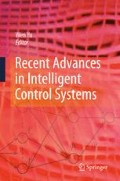Abstract
Real-time autonomous navigation in unpredictable environments is an essential issue in robotics and artificial intelligence. In this chapter, an adaptive neurofuzzy controller is proposed for mobile robot navigation with local information. A combination of multiple sensors is used to sense the obstacles near the robot, the target location, and the current robot speed. A fuzzy logic system with 48 fuzzy rules is designed. Two learning algorithms are developed to tune the parameters of the membership functions in the proposed neuro-fuzzy model and automatically suppress redundant fuzzy rules from the rule base. The “dead cycle” problem is resolved by a state memory strategy. Under the control of the proposed neuro-fuzzy model, the mobile robot can preferably “see” the surrounding environment, avoid static and moving obstacles automatically, and generate reasonable trajectories toward the target. The effectiveness and efficiency of the proposed approach are demonstrated by simulation and experiment studies.
Access this chapter
Tax calculation will be finalised at checkout
Purchases are for personal use only
Preview
Unable to display preview. Download preview PDF.
References
Aguirre E, Gonzalez A (2003) A fuzzy perceptual model for ultrasound sensors applied to intelligent navigation of mobile robots. Applied Intelligence, 19:171-187.
Chatterjee A, Matsuno F (2007) A neuro-fuzzy assisted extended kalman filter-based approach for simultaneous localization and mapping (slam) problems. IEEE Transactions on Fuzzy Systems, 15(5):984-997.
Filliat D, Meyer JA (2003) Map-based navigation in mobile robots: a review of localization strategies I. Cognitive Systems Research, 4:243-282.
Gao J, Xu D, Zhao N, Yan W (2008) A potential field method for bottom navigation of autonomous underwater vehicles. Intelligent Control and Automation, 7th World Congress on WCICA, 7466-7470.
Hagras H, Callaghan V, Colley M (2000) Online learning of the sensors fuzzy membership functions in autonomous mobile robots. Proceedings of the 2000 IEEE International Conference on Robotics and Automation, 3233-3238, San Francisco.
Hong J, Choi Y, Park K (2007) Mobile robot navigation using modified flexible vector field approach with laser range finder and ir sensor. International Conference on Control, Automation and Systems, 721-726.
Kim CT, Lee JJ. (2005) Mobile robot navigation using multi-resolution electrostatic potential field. 31st Annual Conference of IEEEIndustrial Electronics Society, 1774-1778.
Kim MY, Cho H (2004) Three-dimensional map building for mobile robot navigation environments using a self-organizing neural network. Journal of Robotic Systems, 21(6):323-343.
Li H, Yang SX (2003) A behavior-based mobile robot with a visual landmark recognition system. IEEE Transactions on Mechatronics, 8(3):390-400.
Machado C, Gomes S, Bortoli A, et al. (2007) Adaptive neuro-fuzzy friction compensation mechanism to robotic actuators. Seventh International Conference on Intelligent Systems Design and Applications, 581-586.
Marichal GN, Acosta L, Moreno L, et al. (2001) Obstacle avoidance for a mobile robot: A neuro-fuzzy approach. Fuzzy Sets and Systems, 124(2):171-179.
Na YK, Oh SY (2003) Hybrid control for autonomous mobile robot navigation using neural network based behavior modules and environment classification. Autonomous Robots, 15:193-206.
Noborio H, Nogami R, Hirao S (2004) A new sensor-based path-planning algorithm whose path length is shorter on the average. IEEE International Conference on Robotics and Automation, 2832-2839, New Orleans, LA.
Nogami R, Hirao S, Noborio H (2003) On the average path lengths of typical sensor-based path-planning algorithms by uncertain random mazes. IEEE International Symposium on Computational Intelligence in Robotics and Automation, 471-478, Kobe, Japan.
Park K, Zhang N (2007) Behavior-based autonomous robot navigation on challenging terrain: A dual fuzzy logic approach. IEEE Symposium on Foundations of Computational Intelligence, 239-244.
Rusu P, Petriu EM, Whalen TE, et al (2003) Behavior-based neuro-fuzzy controller for mobile robot navigation. IEEE Transactions on Instrumentation and Measurement, 52(4):1335-1340.
Song KT, Sheen LH (2000) Heuristic fuzzy-neuro network and its application to reactive navigation of a mobile robot. Fuzzy Sets and Systems, 110(3):331-340.
Sun F, Li L, Li HX, et al (2007) Neuro-fuzzy dynamic-inversion-based adaptive control for robotic manipulators-discrete time case. IEEE Transactions on Industrial Electronics, 54(3):1342-1351.
Ulrich I, Borenstein J (2000) Vfh*: Local obstacle avoidance with look-ahead verification. Proceedings of the 2000 IEEE International Conference on Robotics and Automation, 2505-2511, San Francisco, CA.
HaiPeng Xie (2008) Wireless networked autonomous mobile robot-i90 sentinel2 user guide. Available at http://www.drrobot.com/products/item downloads/Sentinel2 1.pdf.
Yang SX, Meng QH (2003) Real-time collision-free motion planning of mobile robots using neural dynamics based approaches. IEEE Transactions on Neural Networks, 14(6):1541-1552.
Yang SX, Moallem M, Patel RV (2003) A novel intelligent technique for mobile robot navigation. IEEE Conference on Control Applications, 674-679.
Zhu A, Yang SX (2004) A fuzzy logic approach to reactive navigation of behavior-based mobile robots. IEEE International Conference on Robotics and Automation, 5:5045-5050.
Zhu A, Yang SX (2007) Neurofuzzy-based approach to mobile robot navigation in unknown environments. IEEE Transactions on Systems, Man, and Cybernetics, Part C: Applications and Reviews, 37(4):610–621.
Author information
Authors and Affiliations
Editor information
Editors and Affiliations
Rights and permissions
Copyright information
© 2009 Springer London
About this chapter
Cite this chapter
Zhu, A., Yang, S. (2009). An Adaptive Neuro-fuzzy Controller for Robot Navigation. In: Yu, W. (eds) Recent Advances in Intelligent Control Systems. Springer, London. https://doi.org/10.1007/978-1-84882-548-2_12
Download citation
DOI: https://doi.org/10.1007/978-1-84882-548-2_12
Publisher Name: Springer, London
Print ISBN: 978-1-84882-547-5
Online ISBN: 978-1-84882-548-2
eBook Packages: EngineeringEngineering (R0)

